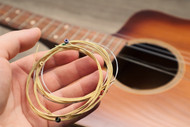Exploring The Impact of Different Materials on Guitar String Tone
Jan 4th 2024

Exploring the Impact of Different Materials on Guitar String Tone
It’s no secret there are a lot of guitar strings out there. At Strings and Beyond, we carry more than 30 brands, and a manufacturer can have dozens of options just for regular six-string acoustic and electric guitars. It’s enough to make your head spin.
There are a lot of factors to consider when shopping for guitar strings, including the string gauge and construction method. The string material, though, is always a good place to start. Bluegrass twang, heavy metal drive, smooth jazz…you’ll need the right guitar string materials to play all of them. You don’t want to sound like Judas Priest when you’re playing James Taylor.
In this guide, we’re looking at some common materials for guitar strings, what they sound like and when you might use them. By knowing what your guitar strings are made of, you’ll also know what your sound is made of.
Wrap vs. Core Materials
Before starting, we should note that unless otherwise specified, we are referring to the wrap material when talking about guitar strings. This is what surrounds the core wire. While there are exceptions, most modern guitar strings have a steel core. The core can be designed in different ways to impact the sound — for example, having a round vs. hexagon shape — but it is not as important as the wrap material.
Interestingly, on both acoustic and electric steel string guitars, only the bottom four strings (low E-A-D-G) have a wrap wire. The B and high-E strings are plain steel, as these strings are too thin for effective wrapping. However, they many still have some sort of plating or protective coating to resist rust.
Now what are those wrapping materials? Cue the music…

80/20 Bronze
This is one of the two most common alloys used for acoustic guitar strings. The name refers to the string wrapping being made of 80% copper and 20% zinc, a combination that produces a bright, crisp initial tone. They will gradually mellow out as the strings age. An 80/20 bronze string set is good for most modern music styles, including rock, country, folk and bluegrass.
Phosphor Bronze
These are the other strings that acoustic guitar players gravitate to. They are made of 92% copper and 8% tin phosphide, creating a warm, balanced and consistent sound with more of the midrange. Meanwhile, the phosphor helps the strings last longer. Phosphor bronze strings can be played for all the same music as 80/20 bronze strings and may be better for frequent gigging musicians who don’t want to constantly change strings.
Pro Note: You will rarely see 80/20 bronze or phosphor bronze strings for electric guitars. This is because most electric guitars use electromagnetic pickups. Bronze is nowhere near as magnetic as other string metals, so the signal is usually too weak.
Silk and Steel
With these strings, a silk or nylon layer is added to the steel core before wrapping them. Silk and steel guitar strings have a mellow, gentle, full and well-rounded sound. This is excellent for traditional folk, jazz and even classical music. They have less tension than a regular steel string, which helps finger-style players. Think of this material composition as a hybrid between acoustic guitar and classical guitar strings.

Nickel-Plated
Perhaps the most popular string design today, nickel-plated steel strings — which have a wrapping material that is roughly 8% nickel and 92% steel — are widespread among electric guitarists (and some acoustic guitarists, too). Nickel-plated wrapping material gives you a reasonably bright sound and excellent overall output. They’re somewhat aggressive but not overly so, making them a versatile option for everything from metal to country.
Pure Nickel
These were some of the earliest electric guitar strings, being widespread throughout the 1950s and 1960s. The 100% nickel wrapping gives you a warmer and mellow tone with a quieter output. Nickel strings remain a good choice among blues players, “root rock” players and anyone looking for a vintage sound, though they will be stiffer and harder to play.
Stainless Steel
This is the brightest-sounding electric guitar string on the market. It will cut through the rest of the band, making it ideal for a variety of rock-based music. Bass guitarists like stainless steel strings as well because they can brighten up a mellow-sounding instrument. As a bonus, stainless steel is rust-resistant for those with highly acidic sweat.
Monel
Though relatively rare today, Monel was one of the first metal guitar string alloys. This combination of nickel and copper offers a warm vintage tone. The strings are a little quieter but very clear. Monel strings will give you a retro rock or jazz sound, and some musicians use them if they have a particularly twangy instrument they want to harness a bit.

Nylon
This remains the string of choice for classical guitars as well as older folk, Spanish and jazz guitars. Nylon has a very mellow, warm tone, and the light attack works very well for music that has a sweeping, majestic sound. While nylon strings tend to just be nylon, you can also find them wrapped in many of the metals mentioned above to further alter the sound characteristics.
Final Thoughts
It’s important to remember this is a general discussion about how guitar string materials sound. Each company has little variances in material composition, gauges and design that make them unique. For example, even though they’re nickel-plated, Ernie Ball Slinky strings won’t sound quite the same as D’Addario XL strings.
Regardless, we hope you can use this information as a jumping-off point to find the right strings. Use our search filters to locate a new set of strings at a discounted price.

